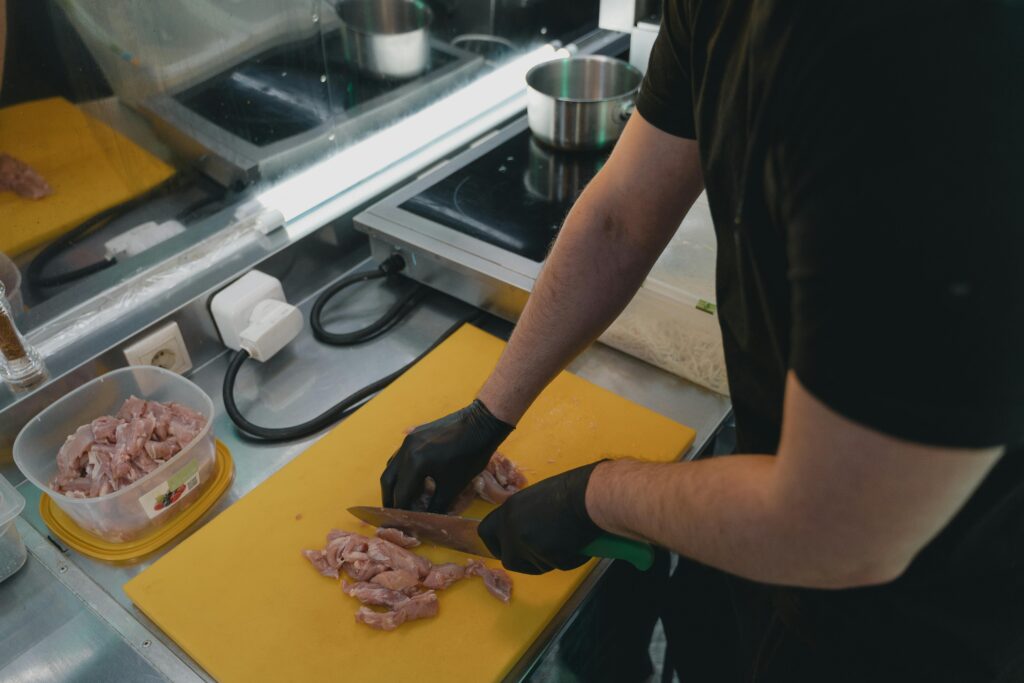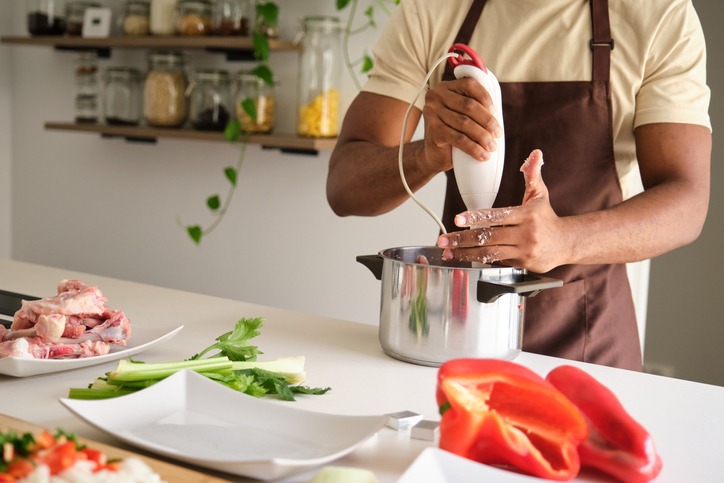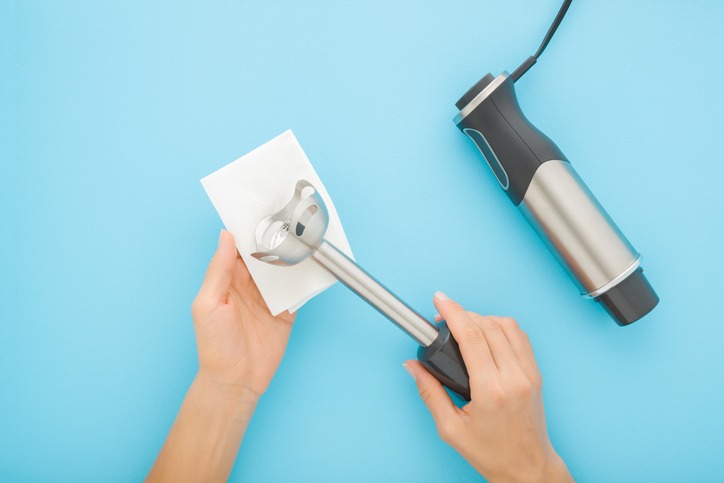Did you know that over 60% of home cooks have tried using their blender for tasks beyond smoothies, including grinding meat? While this may seem like a convenient hack, there are several considerations you must take into account to ensure it’s safe.
Your blender’s motor strength and blade sharpness are critical factors, but there’s more to it than just the hardware. From the type of meat you choose to how you prepare it for blending, each step plays a crucial role in the outcome. Stick around to uncover the do’s and don’ts that could make all the difference in your kitchen experiments.
Assessing Blender Safety
Before grinding meat in your blender, it’s essential to check its motor power and blade sharpness to ensure it’s up to the task. Brands like Vitamix blenders are known for their robust motors and keen blades, making them ideal for such a job. But regardless of the brand, you’ve got to make sure your machine can handle the workload.
Chilling meat before you start isn’t just about hygiene; it also ensures that your blender doesn’t overheat while it’s working through the tough fibers. This step is crucial for maintaining safety and getting the best results.
Another key to achieving that perfect grind is working in small batches. It might be tempting to throw everything in at once, but this can lead to overloading and an uneven consistency. Instead, take your time and pulse the meat. Pulsing rather than running your blender continuously helps prevent it from overheating and ensures that every piece is evenly processed.
Following these safety guidelines, like not overloading your blender and pulsing instead of letting it run continuously, are small but significant steps you can take to ensure your meat grinding endeavor is both safe and successful.
Preparing Meat for Grinding
Before you start grinding meat in your blender, it’s crucial to select the right cuts and prepare them correctly. You’ll need to trim off any unwanted parts and cut the meat into uniform pieces, ensuring they’re small enough to blend smoothly. Additionally, freezing the meat slightly can improve the texture of the grind, making for a better end result.
Meat Selection Tips
When preparing meat for grinding, it’s crucial to first cube the beef to ensure an even grind and consistent texture. Chopping the meat into small, uniform pieces will make the grinding process much smoother. It’s advisable to use your blender to grind meat only after these pieces have been properly prepared.
Before grinding, consider freezing the cubed meat for 10-15 minutes. This step helps maintain the meat’s integrity, allowing for a better ground product. However, be cautious with frozen meat as it may alter the texture during blending.
Also, avoid marinating the meat before you grind it, as this can change its texture and consistency, impacting the final ground meat’s quality.
Cutting Meat Properly
To prepare meat for grinding, start by cubing it into uniform pieces to ensure a smooth blend in your blender. When you cut the meat, always use a sharp knife to remove excess fat, bones, and connective tissue. This step is crucial not only for the quality of your ground meat but also to prevent any damage to your blender blades.
Aim for uniform pieces when you cube meat; this consistency helps achieve the desired texture in your final dish. It’s also important to avoid marinating your meat before grinding. Marinating can alter the meat’s texture, making it less ideal for grinding.
Freezing for Better Texture
Freezing your meat for a brief period, specifically 10-15 minutes, can significantly enhance its texture and facilitate a smoother blending process. By doing so, you’re not just ensuring a better consistency; you’re also reducing the risk of bacterial growth, which is crucial for safe consumption. Remember, cold meat blends better, preventing over-processing and maintaining the integrity of your meat.
Avoid marinating your meat before freezing and blending, as it can alter the desired texture and consistency. Here’s a concise guide:
| Stage | Benefit | Consideration |
|---|---|---|
| Pre-freezing | Enhances texture | Avoid marinating |
| Cold meat | Reduces bacterial growth | Monitor blending time |
| Cubed before freezing | Prevents over-processing | Maintain integrity |
| Blending process | Achieves smoother consistency | Watch for consistency |
| Post-blending | Ready for use or further cooking | Ensure even blending |
This method ensures your blended meat is perfect for cooking and enjoying, with a texture that’s just right.
Grinding Process Steps
Now that you’ve got your meat prepped, let’s move on to the grinding process steps. You’ll need to ensure your blender is up for the task, as the right equipment is key to safe and efficient meat grinding. Then, it’s all about mastering the blending techniques to achieve the perfect texture without compromising on safety.
Choosing the Right Blender
When selecting a blender for grinding meat, it’s crucial to opt for one with a powerful motor and sharp blades to ensure effectiveness and efficiency. To ensure that your blender is suitable for grinding meat, consider the following table highlighting key aspects:
| Feature | Importance | Why |
|---|---|---|
| Motor Power | High | Powers through tough meat. |
| Blade Sharpness | Critical | Ensures fine, even grind. |
| Capacity | Moderate | Matches meat volume to grind. |
| Detachable Blades | Preferred | Facilitates easy cleaning. |
| Material Quality | Essential | Ensures durability and longevity. |
Selecting the right powerful blender with the appropriate features for the grinding process is essential. Look for durable, easy-to-clean models that can handle the job. Remember to work in smaller batches and keep the meat cold to achieve the best results.
Preparing Meat for Grinding
Before grinding your meat in the blender, it’s essential to prepare it properly to ensure the best texture and safety. Using a blender to grind raw meat requires a few key steps:
- Keep the meat as cold as possible, ideally below 40 degrees Fahrenheit, to prevent bacterial growth.
- Remove excess fat, bones, and connective tissue with a sharp knife for a cleaner grind and better texture.
- Cut the meat into small, uniform pieces to ensure even grinding and to achieve your desired consistency more efficiently.
When you’re making sausage or any ground meat dish, starting with properly prepared meat is crucial. Working in batches can also help maintain the cold temperature and ensure that each piece reaches the same level of fineness.
Safe Blending Techniques
To ensure your safety and achieve the best results, it’s crucial to follow specific blending techniques while grinding meat in your blender. First, verify your blender is powerful and equipped with sharp blades to grind meat safely. Cut the meat into small, uniform pieces, ensuring efficient blending without straining the machine.
It’s essential to work in small batches; overloading the blender can cause it to malfunction, compromising both the texture of the meat and your safety. Use the pulse feature in short bursts. This allows you to monitor the consistency and texture closely, ensuring you don’t overdo it. Always adhere to proper safety guidelines to prevent any accidents during the grinding process, keeping your blending experience both safe and successful.
Potential Risks Involved
Grinding meat in your blender can introduce several safety risks, especially if the appliance isn’t equipped for such heavy-duty tasks. When your blender isn’t powerful enough to handle dense meat, you’re not just risking an underwhelming meal; you’re courting potential damage to your appliance. Overloading the blender with large chunks can strain the motor and blades, shortening its lifespan and possibly leading to unexpected malfunctions. Moreover, inadequately blended meat won’t just affect the texture and consistency of your dishes; it could also pose health risks if not cooked thoroughly due to being unevenly ground.
To mitigate these risks, consider the following:
- Ensure your blender is designed for heavy-duty tasks to avoid overloading and potential damage.
- Avoid leaving your blender unattended while it’s grinding meat to quickly address any overheating or operational issues that may arise.
- Chop meat into smaller pieces before blending to promote even grinding and protect the motor and blades from unnecessary strain.
Cleaning After Grinding
After addressing the safety risks of grinding meat in your blender, it’s crucial to focus on the importance of thorough cleaning to prevent contamination. Once you’ve finished grinding, immediately disassemble and rinse all removable parts with warm water to stop bacteria in their tracks. It’s not just about a quick rinse, though. You’ve got to use dish soap and warm water to thoroughly clean every component, especially the blade assembly, ensuring you meet hygiene standards.
Here’s a quick guide:
| Step | Action | Why It’s Important |
|---|---|---|
| Disassemble | Remove all removable parts. | Prepares the blender for a deep clean. |
| Clean | Use dish soap and warm water. | Removes food particles and prevents bacteria growth. |
| Sanitize | Apply a vinegar or bleach solution. | Kills any lingering bacteria or odors. |
| Dry & Reassemble | Make sure everything is dry before putting it back together. | Prevents mold or mildew growth. |
Don’t forget to regularly inspect and clean the motor base to maintain the blender’s performance. Proper cleaning and drying not only uphold hygiene standards but also extend the life of your blender, ensuring it’s safe and ready for your next culinary adventure.
Blender Maintenance Tips
Why should you pay attention to blender maintenance? Keeping your blender clean and properly maintained is crucial for several reasons, not least of which is ensuring safe food preparation. Regular maintenance prevents bacterial growth, making sure your food is safe to consume. Additionally, proper care can significantly extend the lifespan of your blender, making it a reliable tool in your kitchen for years to come.
Here are some essential tips for blender maintenance:
Disassemble and clean after each use: Take apart your blender, including the blade assembly and container, and clean them thoroughly with warm, soapy water. This ensures that no food residue remains, which could harbor bacteria or affect the blender’s performance.
Sanitize regularly: Beyond regular cleaning, occasionally sanitize your blender to eliminate any lingering bacteria or germs, ensuring it’s always safe for food preparation.
Avoid abrasive cleaners: To keep your blender in top condition, steer clear of abrasive cleaners that can scratch or damage the blender’s components. This not only helps maintain its appearance but also ensures it functions correctly for longer.
Conclusion
Grinding meat in your blender can be both safe and convenient if you’re careful. Ensure your blender’s up for the task with a powerful motor and sharp blades, and always start with cold, cubed meat. By adding it gradually, you’ll achieve the best texture while minimizing risks.
Don’t forget to clean thoroughly afterward and keep up with regular maintenance. With these steps, you’ll enjoy freshly ground meat without compromising on safety or flavor.





